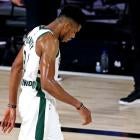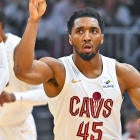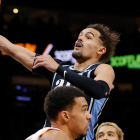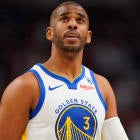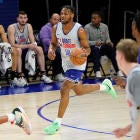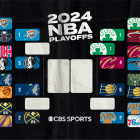
Editor's note: This piece on the Bucks was originally published on Sep. 2, 2020. It was updated two days later, with Milwaukee trailing 3-0 in its second-round series.
Channing Frye hasn't forgotten the game he played on March 4, 2016. You tend to remember when your team makes history.
The 3-pointers kept falling for the Cleveland Cavaliers, eight of them in the first quarter, 10 in the second. They led the Atlanta Hawks 74-38 at halftime, and when the 25th 3 left Mo Williams' hands in garbage time, all of their starters were already on their feet.
On the night Cleveland broke the single-game NBA record for 3s made, Frye hit only one of them. LeBron James or Kyrie Irving repeatedly collapsed the Hawks' defense and found whoever happened to be open.
"On film they were very easy to decipher," Frye, now an NBA analyst for Turner Sports, said. "Especially with Kyrie and Bron, who can get past their first defender. So the minute that the first defender goes by them, then they're in constant rotations. And then it's just like, who's the best shooter? And we were very unselfish."
Two nights later, Frye went 7 for 9 from deep and scored a playoff career-high 27 points in 28 minutes.
"They left me and Kevin [Love] open a lot," Frye said. "And we were like, what? But we were prepared for that."
Atlanta finished the 2015-16 regular season with the league's second-best defensive rating. The roster was stocked with high-IQ players, and it managed to force tons of turnovers without committing many fouls. The Hawks defended the rim well and steered opponents toward long 2s, but the Cavs knew that they also allowed a lot of uncontested 3s. And Frye knew that "contested" 3s are not created equal.
"Certain teams don't put small guys in rotations with me because I'm 7 foot," Frye said. "So I remember I would have Jeff Teague jumping at me or Kent Bazemore or Kyle Korver. And those guys aren't affecting my shot at all."
Frye reminisced about the series, which ended in a Cleveland sweep, because of the parallels between those Hawks and the team that has had the NBA's best record, best defensive rating and best net rating for two seasons running. Nobody comes close to matching the Milwaukee Bucks' rim protection and almost nobody forces more long 2s, but they give up more wide-open 3s than any team in the league. Like those Hawks, they are coached by Mike Budenholzer.
"Bud is a great coach, man," Frye said. "And you can tell that these teams are pretty disciplined. That these teams are well coached, they practice their defensive rotations.
"But again," Frye continued, if you can get the Bucks in rotation, you can get clean looks. Often, a simple pick-and-pop will do, if you happen to have a Frye-esque floor-spacing center. Milwaukee defends ball screens with "drop coverage," keeping the big man in the paint and nudging the ball handler toward the midrange. It helps aggressively on drivers, even if it means leaving a shooter open in the corner, a cardinal sin for most teams.
Giannis Antetokounmpo is the Defensive Player of the Year and will likely soon be the back-to-back MVP. Cases can be made for Bucks center Brook Lopez and guard Eric Bledsoe to join him on the All-Defensive team. Budenholzer, the 2015 and 2019 Coach of the Year, has designed a defense that accentuates their strengths: The guards fight over screens, contest pull-up jumpers from behind and prevent dribble penetration. Lopez patrols the paint and shouts instructions. Antetokounmpo blows up actions all over the court. The system works the vast majority of the time.
As the Bucks have chased a title, though, it has been difficult to forget the time that it didn't.
Last season's Eastern Conference finals loss to the eventual-champion Toronto Raptors has loomed over the Bucks' entire season. They won the first two games, lost the third in overtime and then lost control. There was no series-changing injury, just a sense that the Raptors had figured things out. Marc Gasol shot 3s without hesitation, Fred VanVleet caught fire and Kawhi Leonard pinched Milwaukee's pressure points.
In Game 5, Budenholzer's coaching staff deviated from its defensive scheme by switching, but Milwaukee wasn't used to it. Unbothered, Leonard drained 3s over Lopez.
Toronto provided a stark contrast. It swarmed Antetokounmpo in all of his favorite spots, from all sorts of angles. All season, it had experimented with coverages, and the way it beat the Bucks was different from the way it beat the Philadelphia 76ers and, later, the Golden State Warriors. Coach Nick Nurse deployed a box-and-one and a triangle-and-two in the Finals, and has been even more creative with the Raptors since. By dialing up their aggressiveness and unpredictability, they had the best defensive rating of any team outside of Milwaukee, despite losing Leonard and Danny Green.
"The Raptors' defense keeps even one-on-one guys off-kilter," Frye said. "Because they don't know where the double-team is coming [from]. Are they going to get double-teamed? Is it a baseline double? Is it a top double? They don't know who is coming from where, and are they in a zone, are they showing, are they switching? It's hard to score on that. You can't get a rhythm."
It's also harder to defend that way. Nurse didn't introduce all the unconventional stuff on Day 1, and it wouldn't work so smoothly without a starting lineup full of All-Defense types on board with the plan. Over the course of a grueling regular season, keeping things simple means less work. The Bucks have clear rules, and they follow them with discipline. Defense in the modern NBA -- where some lineups feature five guys who can dribble, pass and shoot -- is challenging enough without having to keep track of continually changing coverages.
But if you aren't adaptable, if you allow star players to get comfortable, if you do not use the regular season to try new things, then the playoffs can be a shock to the system.
"In playoffs, you have to be able to adjust," Frye said. "If you don't have the personnel to adjust, then you have to stick with what you can do. But it also limits you because, if a guy starts cooking that defense, then what's going to happen? What do you change? You just say 'Hey, we need to do us, we just need to do us better?' That doesn't make any [sense]. It doesn't work like that with really good teams. And you saw that with Kawhi."
Frye turned himself into a stretch 5 in Phoenix, where he was blessed with Steve Nash as his pick-and-pop partner. Every time he faced a paint-bound big man, he knew the ball would be coming to him. He knew which teams would switch, which teams would show, how much room his man would give him. He understood that the defense might dictate that he doesn't touch the ball for a quarter, but his job was to stay ready to shoot.
P.J. Tucker's job requires the same conviction. A month ago, the Houston Rockets center missed a wide-open corner 3 against the Bucks. It was his his fifth straight misfire from deep, and he would miss yet another before the first half ended. "He's going to have to shoot it, he's going to have a lot of chances," ESPN announcer Jeff Van Gundy said on the broadcast.
Van Gundy was right. At halftime, Tucker shot 3s in the corner while the rest of the team was still in the locker room. On the first possession of the third quarter, the NBA's most prolific corner 3-point shooter finally made one. It was open because Lopez was in position to help against Russell Westbrook.
Tucker finished the game 3 for 12 from 3-point range, but made a clutch one in the corner as part of a 16-4 Rockets run that left Milwaukee with a 120-116 loss. Houston made 21 3s and tied an NBA record by attempting 61 of them.
The next day, some Rockets players encountered a group of Brooklyn Nets at the pool at the Grand Floridian. The Nets' next opponent was the Bucks, so they asked for tips. The advice was simple, according to Brooklyn guard Chris Chiozza: They will give up a lot of 3s, so be ready to knock them down. If you miss, keep shooting.
The depleted Nets beat Milwaukee 119-116 the next day, going 21 for 57 from deep. The Bucks were not at full strength, either -- Lopez rested, and Antetokounmpo and Khris Middleton took the second half off -- but Brooklyn bombed its way to a 40-point first quarter against most of their regulars.
Before the playoffs started, Orlando Magic forward James Ennis was optimistic. "We're going to get a lot of open looks," he said on a Zoom conference. "If we're hitting, man, it's going to be scary. It's going to be scary for Milwaukee." This seemed laughable from a journeyman on the eighth seed, not to mention one of the league's poorest-shooting teams, but Orlando won the opener by double digits. The Magic shot their 3s with confidence, and center Nikola Vucevic scored 35 points, going 5 for 8 from deep.
The Bucks didn't lose again in the series, even with Vucevic going off for two more 30-point games, as should be expected of a No. 1 seed with a massive talent advantage. But what if they don't have a massive talent advantage, and the other team can spread them out?
"That is a problem," Frye said.
On Aug. 8, the Dallas Mavericks played 53 minutes of five-out offense against Milwaukee. Luka Doncic shredded the Bucks to the tune of 36 points and 19 assists, and the Mavs won 136-132 in overtime.
One of Doncic's highlights conjured that way-too-stressful Super Mario Maker video you've seen on Twitter -- surrounded by defenders on a drive, he stopped on a dime, jumped and turned away from the basket, throwing the ball between Bledsoe's raised arms, directly to an open teammate:
It was a stupefying pass, a testament to the genius of Doncic. You could watch it 100 times and still wonder how he saw Dorian Finney-Smith standing at the 3-point line. Given how Milwaukee was defending, though, did Doncic need to see Finney-Smith? He could see four Bucks converging and could feel a fifth on his tail. If he could somehow get the ball out to the perimeter, chances were good that an open Maverick would catch it.
On Monday, in the first game of Milwaukee's second-round series, Doncic's mentor, Goran Dragic, pulled off something similar (but not as spectacular): a wraparound pass thrown in midair, underneath the basket, over the hands and heads of three Bucks defenders. The pass wasn't perfect, but it didn't have to be. Dragic and the diving Bam Adebayo had pulled in Milwaukee's defense, and no one was in the vicinity of Jimmy Butler:
Butler and Dragic put the Bucks in precarious predicaments throughout. When Adebayo went to the bench in the second half, Miami Heat coach Erik Spoelstra went centerless, with Butler, Jae Crowder and Andre Iguodala comprising their frontcourt. Budenholzer went "small" when Lopez sat, but stayed in drop coverage. Marvin Williams even earned a defensive three-second violation, parked in the paint on a pick-and-roll.
In crunch time, Butler made a series of floaters, midrange jumpers and a 3 off the dribble. He scored 13 points in the final four minutes, typical star stuff, and Miami earned with a 115-104 win. During the Heat's 16-6 run, Antetokounmpo was mostly stationed in the opposite corner, matched up with Crowder. It brought back memories of Leonard and the conference finals, especially because Milwaukee's offense stagnated and Antetokounmpo went cold from the free throw line.
With less than three minutes left in Game 3 on Friday, Butler found Crowder with a pass just like the one he caught from Dragic four days earlier. The open 3 gave Miami a seven-point lead, which Milwaukee could not overcome. Butler alone outscored the Bucks 17-13 in the fourth quarter, and the Heat finished the game on a 17-1 run, taking a 3-0 lead in the series.
Coming into the playoffs, nobody doubted that the Bucks were contenders. "Offensively and defensively they are just ridiculous," Frye said, even though they give up a "scary" amount of 3s. The skepticism that has existed for the better part of two years, though, is about Milwaukee's ability to shift shapes when the situation demands it, to improvise when Plan A isn't working. A couple of weeks before the hiatus, Budenholzer stood in the hallway of Scotiabank Arena, the site of their conference finals heartbreak, and said the Bucks believe in building habits, in staying true to their identity.
"We kind of do what we do," Budenholzer said, "and hopefully it's good enough."
Unless they manage the greatest playoff comeback in NBA history, the verdict is in: Doing what they do is not good enough. At their best, all of the pieces seemed to be arranged perfectly, in an elegant system that produced mind-boggling numbers. The postseason, though, forces teams to find ways to win when they're not at their best. And while Milwaukee's opponents are fighting a war of inches, it continues to willingly cede ground.













